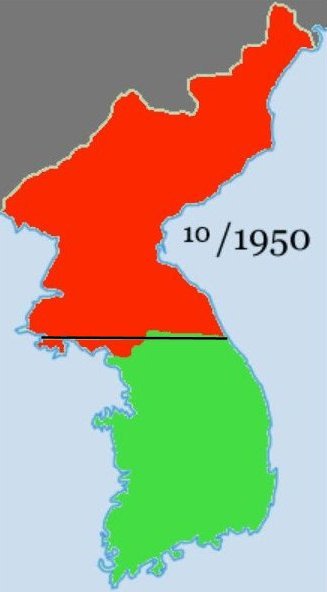
|
Korean War Time Line June 1950 to July 1953
5. Position of Forces in October 1950
On 30 September, Zhou Enlai warned the U.S. that China was prepared to
intervene in Korea if the U.S. crossed the 38th parallel. Zhou attempted to
advise North Korean commanders on how to conduct a general withdrawal by using
the same tactics which had allowed Chinese communist forces to successfully
escape Chiang Kai-shek's Encirclement Campaigns in the 1930s, but by some
accounts North Korean commanders did not utilize these tactics effectively.
Bruce Cumings argues, however, the KPA's rapid withdrawal was strategic, with
troops melting into the mountains from where they could launch guerrilla raids
on the UN forces spread out on the coasts.
By 1 October 1950, the UN Command repelled the KPA northwards past the 38th
parallel; the ROK Army crossed after them, into North Korea. MacArthur made a
statement demanding the KPA's unconditional surrender. Six days later, on 7
October, with UN authorization, the UN Command forces followed the ROK forces
northwards. The X Corps landed at Wonsan (in southeastern North Korea) and
Riwon (in northeastern North Korea), already captured by ROK forces. The Eighth
U.S. Army and the ROK Army drove up western Korea and captured Pyongyang city,
the North Korean capital, on 19 October 1950. The 187th Airborne Regimental
Combat Team ("Rakkasans") made their first of two combat jumps during the
Korean War on 20 October 1950 at Sunchon and Sukchon. The missions of the 187th
were to cut the road north going to China, preventing North Korean leaders from
escaping from Pyongyang; and to rescue American prisoners of war. At month's
end, UN forces held 135,000 KPA prisoners of war.
Taking advantage of the UN Command's strategic momentum against the communists,
General MacArthur believed it necessary to extend the Korean War into China to
destroy depots supplying the North Korean war effort. President Truman
disagreed, and ordered caution at the Sino-Korean border.
⇦ September 1950
On to November 1950 ⇨
Back to Korean War Time Line June 1950 to July 1953 - Page 1
|
